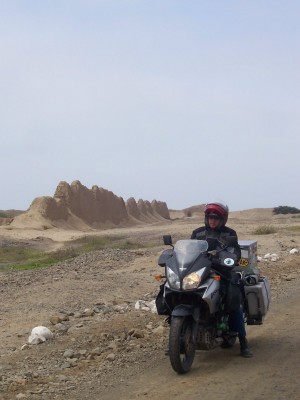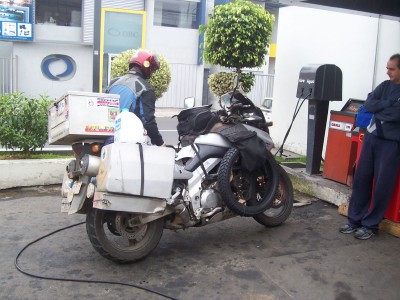All the sand you can eat

Road to Caral
The deep sandy track continued on in a seemingly endless search for the horizon. With the worn front tyre next to useless in these conditions we ploughed on through steadfastly resolute on our destination. Miss Piggy showing sure-footed stability inspired us to confidence.
Sandy Track - Supe Valley
We were told it was impossible to get there on the bike and we needed to take an organised tour. Being undeniably cheap and stubborn we thought we would head out on the road and if it was impassable we could turn back.

Supe Valley - Caral
Departing the Panamericana the sweet pungent smell of unions greeted us on the cool damp morning. Their green leaves carpeting the valley floor along with fields of potatoes, pumpkins and corn, crops grown in this valley for, probably, thousands of years.

Are we there yet?
For the first 10 kilometers the road, though loose and narrow proved quite rideable. We passed through a small unamed town on the edge of the river bed, covered in mist and eeriely quiet where the road divided into two.

Village in the Supe Valley
Jules approached one of the few locals to be seen in the village enquiring about the direction to Caral. He indicated with a point and a grunt to follow the road straight ahead. On continuing, we climbed the edge of the valley where the road became little more than a goat track deteriorating into a steep rocky incline before descending into a flowing creek bed and continuing on as mud, rock, sand and finally yet deeper sand.

Arrival at Caral
Caral, our destination, a magnificent archeological site in the Supe Valley. The City with its pyramids, large circular astronomical structures and complex urban society flourished for perhaps 500 years almost 5000 years ago parallel with the civilisations of Egypt.
The location is equally as impressive with the city being built on and around enormous sand dunes with even higher mountains surrounding the valley. The colours are superb and the atmosphere, for us, electric. Much excavation work is still underway with archeologists and their assistants can be seen with all thier working parapheanalia.

Pyramid - Caral
This archeological site is changing many of the accepted theories of early organised human occupation in this part of the world. It was truly, for us, an exceptional experience and one we will alway remember.
BORDER CROSSING
An early morning border crossing set in a stunning valley on the international bridge over the Rio Macara.
Exit Ecuador - Macara
* Go to Immigration and have passports stamped out,
* Go to customs and return temporary import papers for the bike. They will make you a copy and keep the original.
* Cross the bridge to Peru.

Ecuador - Peru Border
Enter Peru - La Tina
* Go to Immigration and have passports stamped in.
* Go to Customs and have temporary import papers drawn up for the bike.
Welcome to Peru. The whole process took only 45 minutes. The staff at this crossing were very helpful and friendly.

Country Kitchen
Coming down from the cool mountains of Ecuador we encountered the Egypt of South America, the beautiful white sands of the Sechura Desert.

Sechura Desert - Peru
Passing through many small villages, often consiting of mud brick, stick and reed mat dwellings, areas of sand dunes and surprisingly green plantations irrigated from the precious waters of the Amazon Watershed via a series of tunnels (the longest at 16kms), canals and channels through the Andean mountain chain.

Village in the Sand - Piura
Chiclayo made a nice base to explore the region. An oasis in the desert, home to the largest Mercardo de Brujas (Witches Market) in South America, colonial churches, modern shopping plazas and cinemas. A very comfortable city and our favourite in Peru.

Chiclayo Skyline
We rode out to Tucume to see one of the many ancient adobe pyramid sites that litter the valley. Tucume, inhabited by the Moche peoples and eventually by the Inca, is now in ruins as the mud bricks slowly return to the earth. However, the site is still impressive, best seen and appreciated from the high mirador of El Purgatorio. Many places are unable to be visited by tourists due to the delicate nature of the adobe.

Jules at Tucume on Mirador Purgatorio
Returning to the town of Lambayeque we visited the Museo de las Tumbas Reales de Sipan. Only after having our camera confiscated and being frisked were we allowed in, such is the value of the treasures in this museum.
The museum encompases the complete burial treasures found in the tomb of the Lord of Sipan and the Old Lord of Sipan. Incredible ornate gold, silver and copper artifacts as well as reconstructions of the actual tomb layout. You could spend a whole day just admiring the displays at this fascinating and beautiful museum.

Cordillera Blanca - Huaraz
There seems to be a conspiracy in Peru, for Grant at least. For 17 months we have travelled with the same hygiene and eating standards and though in some other countries, minor stomach ailments have occurred, almost immediately on entering Peru Grant has had nothing but stomach ailments.

Callejon de Huaylas
From the typical minor gumble or cramping, to an all out onslaught on the digestive tract. Causing the overought victim to have an overly unnatural desire to find the nearest baños (loo) and completely consume every available resource in the said convenience. Great fun!

Gas Station??
Chan Chan, near Trujillo, is the remains of worlds largest adobe city crumbling back into the surrounds over time by harsh weather conditions and grave robbers.
The Ciudadela of Tschudi has been excavated and somewhat restored, showing beautiful carvings of nets, fish and pelicans made first by the Chimu people and then by the Inca. After 11 years of siege the Chimu surrendered to the Incas in 1471 where they took control of the city and archeologists believe copied irrigation systems used by the Chimu for thier own cities.

Fishing Net Bodegas - Chan Chan
With 9 meter high walls surrounding and protecting the smalled dwellings, bodegas, workshops etc it is estimated that the city covered an expanse of 28 square kilometers and the kingdom spread 1000kms along the coast.

Citadel Wall - Chan Chan
We entered Lima on a Saturday and immediately disliked it. With hideous traffic and heavy pollution but it was a necessary stop as we were desperate to purchase a new front tyre for Piggy. Typically, we stayed in Miraflores as it is the lesser of two evils when you come to Lima. After searching for a day we found a dirt biased tyre at Direlli, the Pirelli agent in Lima. Tyres for the bigger bikes are difficult to come by in Peru.
From the following pictures pick the heavily loaded Bike:

At the Gas Station - Lima

Ergonomically Correct Top Box??

BMW Rider from Italy
